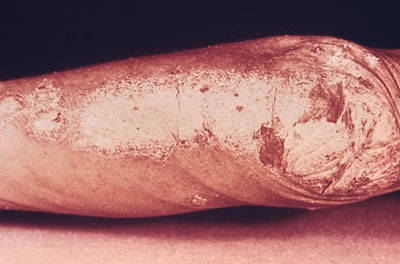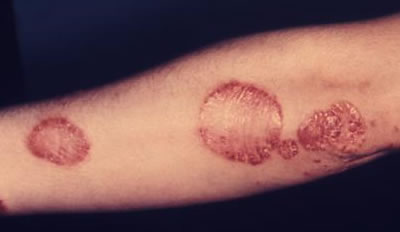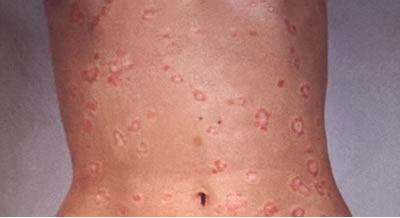Psoriasis
Psoriasis is a chronic skin condition marked
by raised, scaly skin patches called plaques.
Itching, burning, or stinging sensation usually accompany these
plaques.
Psoriasis occurs in cycles, with each flare lasting weeks or
months.
How is it Pronounced?
sor-EYE-a-sus.
Psoriasis Symptoms
The symptoms of psoriasis are:
- Plaques, or raised skin patches with 1/4-in to several inches
in diameter
- Deep pink or red in color
- Silvery, yellow-white scales
- Heavy white scaling or pits and thickening under the nails
Plaques can occur at:
- Scalp
- Elbow
- Knees
- Navel
- Genitalia
- Lower back
- Buttock (or buttock fold)

Psoriasis of the elbow and forearm.

Psoriatic dermatitis patches on the forearm.
Most people with psoriasis only get a few plaques on the elbows
or knees. However, in rare, serious cases, the plaques and pimple-like
pustules can cover the entire body.

Psoriasis found in the abdomen.
In about 5% of the patients, in a condition called arthritic
psoriasis, arthritis will develop in the joints after
the plaque formation.
Who Gets Psoriasis and How Common is it?
Psoriasis occurs most often in adolescents and young adults -
however, it can occur at any age. It is thought to be an inherited
condition - if either parent has it, then it is likely that the
children would have it as well.
It is a very common condition - it is estimated that over 6.4
million people in the United States have psoriasis.
Psoriasis Causes
The exact cause of psoriasis is not known. Flares can be trigerred
by infection, stress, changes in temperature or climate, skin
injury, and alcohol intake. It can also be trigerred by prescribed
medicines, such as lithium and anti-malarial drugs.
Skin cell growth is thought to be linked to the cause of psoriasis:
| |
Normal Skin |
Psoriasis |
| Cell Density (cells / square centimeter) |
27,000 |
52,000 |
| New skin cell production (cells / square centimeter / day) |
1,250 |
35,000 |
| Cell cycle of the skin cell (hours) |
311 |
36 |
In summary, in psoriatic skin, skin cells reproduce about 10x
faster and exist in a far higher density than in normal skin.
This results in skin thickening and plaque formation associated
with psoriasis.
Psoriasis Prevention
Psoriasis can be prevented by:
- Avoiding skin injury
Plaques can form following cuts and scratches on the skin.
- Treating infection as early as possible
- Getting enough (but not too much) sunlight
- Avoiding alcohol intake
Treatments of Psoriasis
Psoriasis treatments include:
- Prescribed topical creams or gels (corticosteroids, vitamin
D-, and vitamin A-derivatives)
- Light treatment or phototherapy
In this treatment, the skin is exposed to ultraviolet A (UVA)
light. Sometimes, a medication called psoralen that sensitizes
the skin to uv light is prescribed. This treatment, called PUVA
(for psoralen Ultraviolet A), is given several times a week
at the doctor's office.
- Oral medications (methotrexate and etretinate, which inhibit
skin cell growth and inflammation)
There is no cure for psoriasis. However, the treatment above
can help clear up the plaques and alleviate the symptoms of this
condition.


